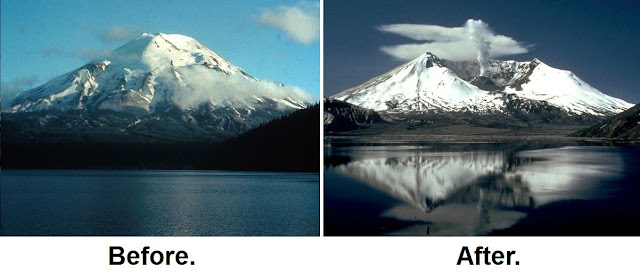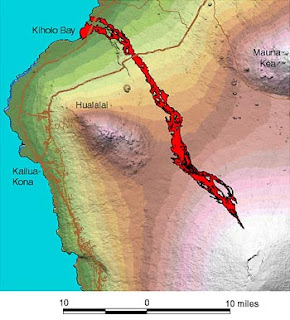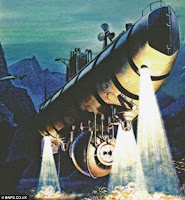n
nPostedn on January 23, 2017
n
n
n
n
n
nInthink of volcanoes erupting over a matter of minutes or hours – notnfor the better part of a year!
n
n
n
nButnthat’s because I think of volcanic eruptions as violent explosivenoutbursts of lava and gas and steam. Mauna Loa, in Hawaii, is thenlargest volcano on the planet partly because its lava tends to bensilica poor, and therefore the lava eruptions tend to be very fluid,nnon-explosive, gentler and slower-moving than many other volcano’s eruptions, although often still quitendestructive.
n
n
n
nSo…whyndoes having silica-poor lava relate to being a large volcano? Simplynstated, Mauna Loa doesn’t blow off its top!
n
n
n
 |
| These pictures of another volcano, Mt. St. Helens, shows that some volcanos DO blow their tops off! Check out the lovely cone that is Mauna Loa, below: |
n
n
n
n Thenslopes of Mauna Loa are generally gentle. The cooling lava makes thenvolcano larger – and, incidentally, makes the island of Hawaiinlarger. The volume of the volcano is estimated to be about 18nthousand cubic miles (75 thousand cubic kilometers). n
Thenslopes of Mauna Loa are generally gentle. The cooling lava makes thenvolcano larger – and, incidentally, makes the island of Hawaiinlarger. The volume of the volcano is estimated to be about 18nthousand cubic miles (75 thousand cubic kilometers). n
 Thenslopes of Mauna Loa are generally gentle. The cooling lava makes thenvolcano larger – and, incidentally, makes the island of Hawaiinlarger. The volume of the volcano is estimated to be about 18nthousand cubic miles (75 thousand cubic kilometers). n
Thenslopes of Mauna Loa are generally gentle. The cooling lava makes thenvolcano larger – and, incidentally, makes the island of Hawaiinlarger. The volume of the volcano is estimated to be about 18nthousand cubic miles (75 thousand cubic kilometers). nn
n
n
nBynthe way, even though Mauna Loa is the largest volcano on Earth, wenare talking about that huge volume, not its height. It isn’t the highestnvolcano on Earth, and even its island neighbor, Mauna Kea, is highernby about 120 feet (37 meters). n
n
n
n
nNow,nabout that 300-day eruption!
n
n
n
n Onnthis date in 1859, Mauna Loa had a brief summit eruption. Then anstream of lava broke out from the volcano’s flank (side), high up butnnot at the top. This outbreak of lava created a 32-mile-long lavanflow, the longest in the state of Hawaii. n
Onnthis date in 1859, Mauna Loa had a brief summit eruption. Then anstream of lava broke out from the volcano’s flank (side), high up butnnot at the top. This outbreak of lava created a 32-mile-long lavanflow, the longest in the state of Hawaii. n
 Onnthis date in 1859, Mauna Loa had a brief summit eruption. Then anstream of lava broke out from the volcano’s flank (side), high up butnnot at the top. This outbreak of lava created a 32-mile-long lavanflow, the longest in the state of Hawaii. n
Onnthis date in 1859, Mauna Loa had a brief summit eruption. Then anstream of lava broke out from the volcano’s flank (side), high up butnnot at the top. This outbreak of lava created a 32-mile-long lavanflow, the longest in the state of Hawaii. nn
n
n
nOnnthe evening of January 30 the lava began to destroy the village ofnWainanali’i on the west coast of the island. I gather that no livesnwere lost, but some people lost everything they owned as well asntheir homes. However, since Mauna Loa’s lava moves relativelynslowly, many people were able to gather their most precious belongingsnand personal effects before escaping to higher ground.
n
n
n
nBynJanuary 31 the lava reached the ocean. This was eight days after theneruption started – and, amazingly, the eruption continued anothern292 days! As the lava continued to flow, it filled fishponds and ofncourse impacted the economy of several communities. n
n
n
n
nThenscience of volcanology was extended during this eruption, since a’a and pahoehoe lava flows could be studiednand compared. It turns out that the two kinds of lava are identicalnchemically; the difference is in their temperature. A’a lava flowsnbecome cool enough that they cannot flow, and so a more broken-up,nrougher rock forms, compared to the smooth-flowing pahoehoe lava flows. n
n
n
n
 |
| A’a lava forming, above, and cool a’a lava, below. |
n
n
n
n
 |
| Pahoehoe lava forming, above, and cool pahoehoe lava, below. |
n
n
n
n
n n
n
n
n
n
n
n
n
nAlsonon this date:
n
n
Anniversary of a Record-Setting Dive
n
n
n
n
n
n
n
n
n
n
n
n
n
n
n
n
nChemistnKarl Ernst Claus’s birthday
n
n
n
n
n
n
n
n
n
n
n
n
n
n
n
n
nAnniversarynof the creation of Liechtenstein
n
n
n
n
n
n
n
n
n
n
n
n
n
n
n
n
n
n
nNationalnHandwriting Day
n
n
n
n
n
n
n
n
n
n
n
n
n
n
n
n
n
n
n
n
n
n
nAnniversarynof the partitioning of Poland
n
n
n
n
n
n
n
n
n
n
n
n
n
n
n
n
n
n
n
n
n
n
n
n
n
n
n
n
n
n
n
n
n
n
n
n
n
n
n
Plannahead:
Plannahead:
n
n
n
nChecknout my Pinterest pages on:
n
- n
-
n
-
nJanuaryn birthdays
n
-
n
n
n
n
n
nAndnhere are my Pinterest boards for:
n
- n
-
n
-
n
-
n
n
n
n
n
n
n
n
n








